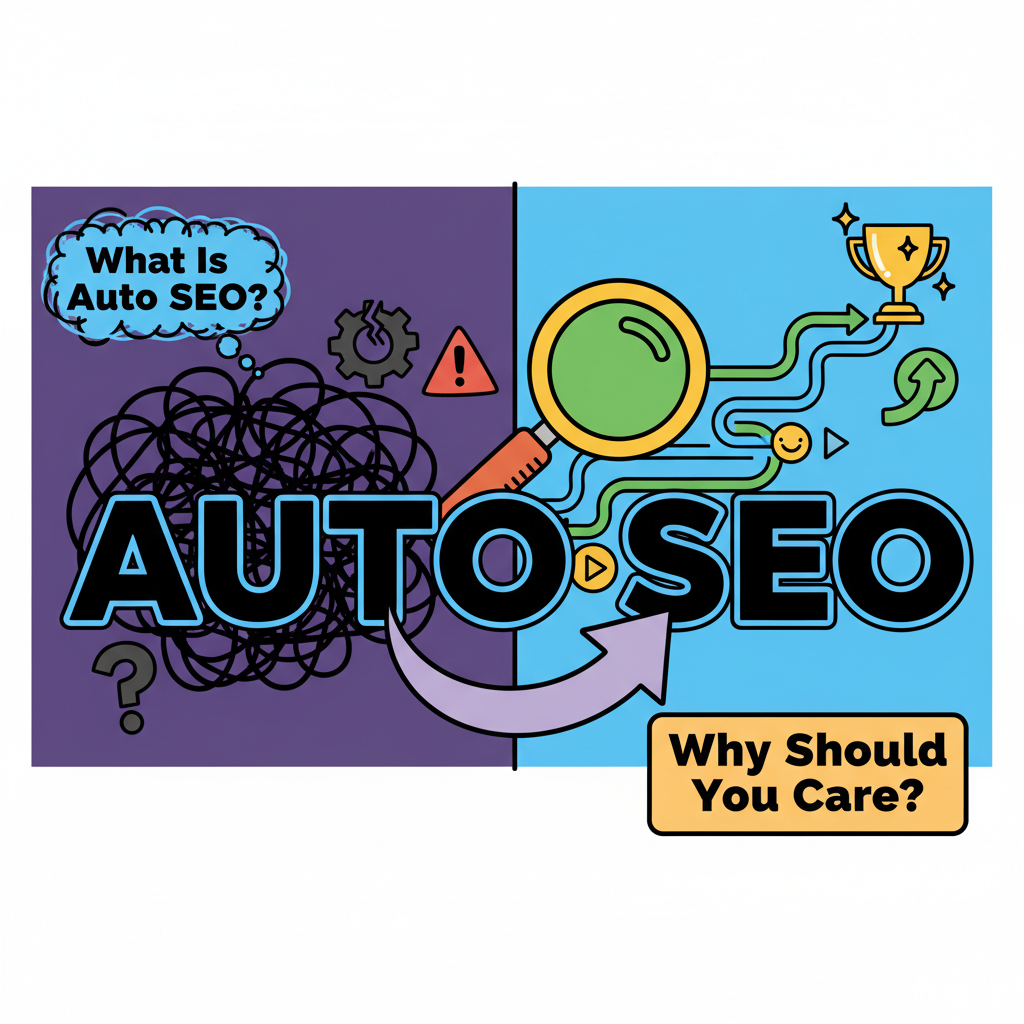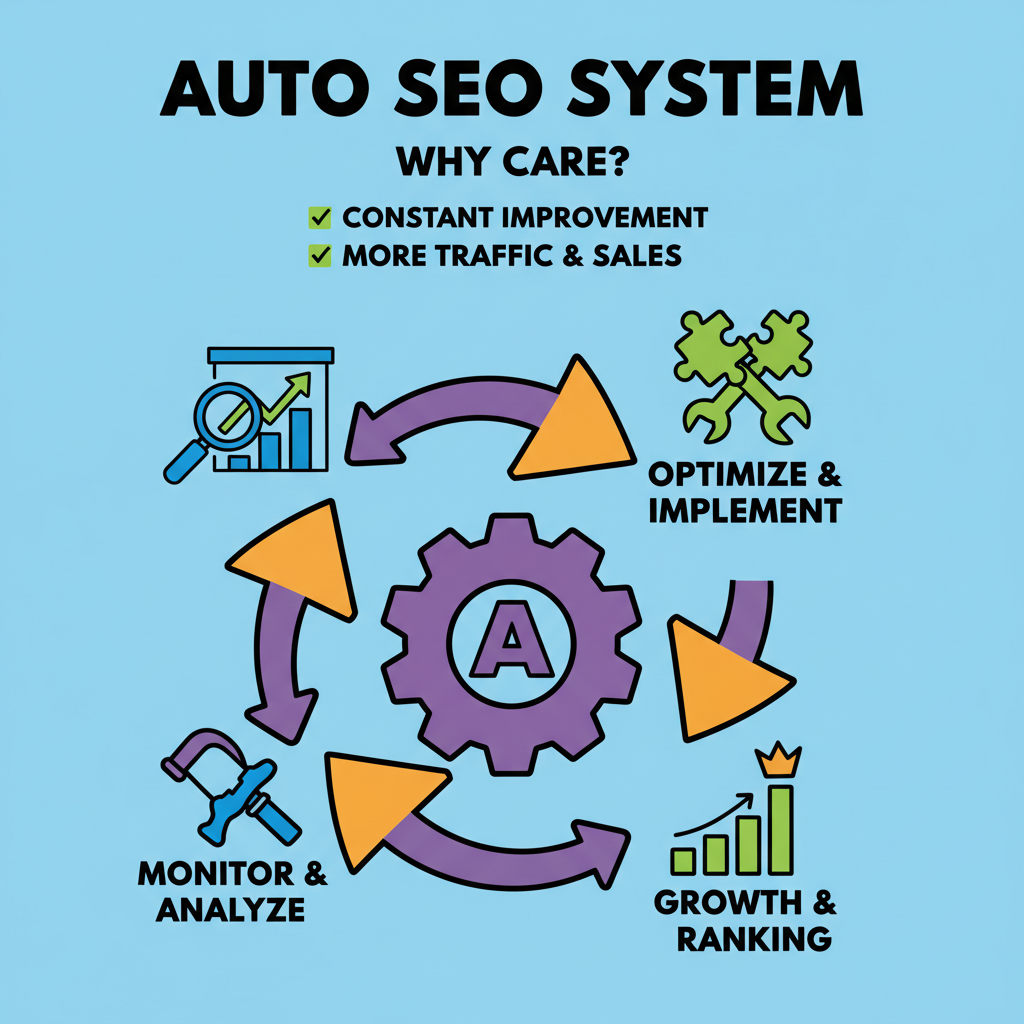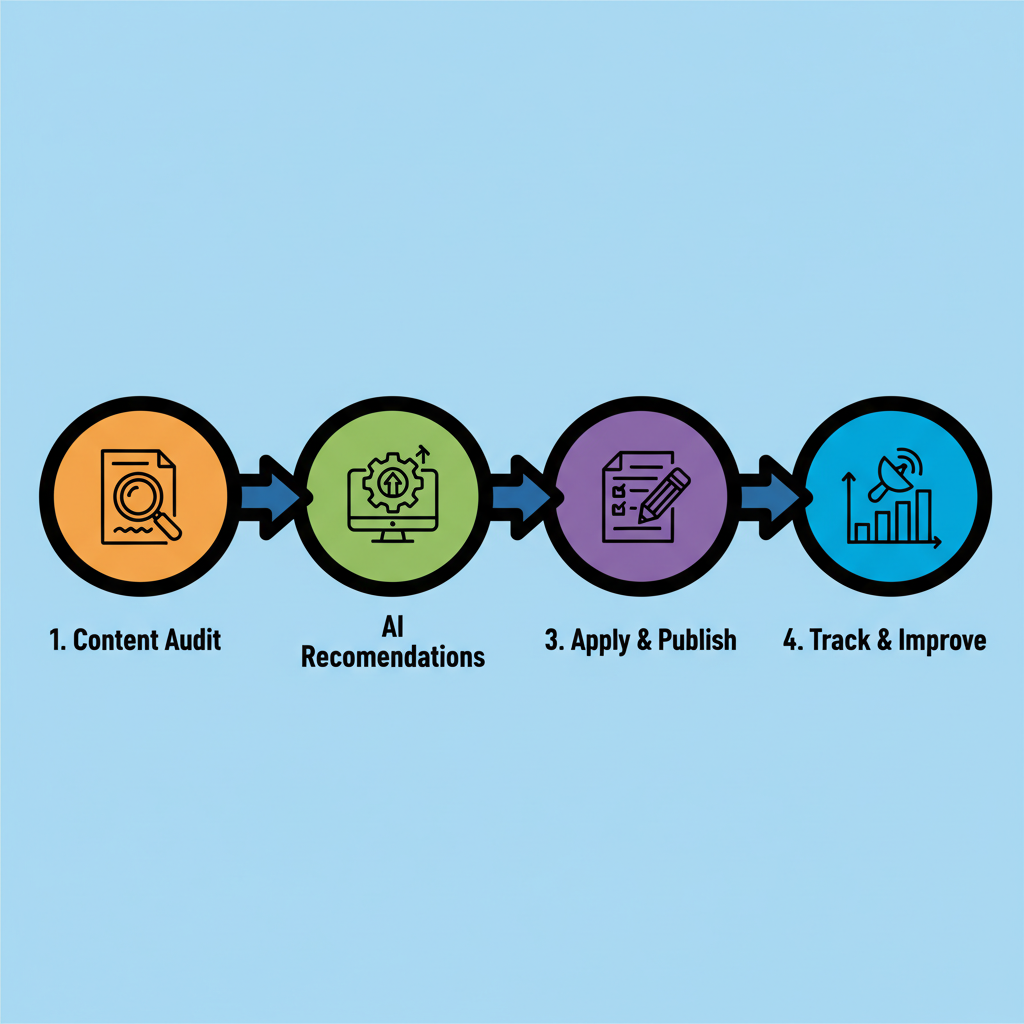What Is Auto SEO and Why Should You Care?
Posted by
How to Implement Auto SEO for Maximum Website Performance

Auto SEO represents the future of search engine optimization, combining intelligent automation with proven SEO strategies to deliver consistent results without constant manual intervention. If you're tired of spending countless hours on repetitive SEO tasks while watching your competitors climb the rankings, implementing an automated SEO system could be the game-changer your website needs. This comprehensive guide will walk you through everything you need to know about setting up and optimizing auto SEO for your website, from understanding the core components to measuring long-term success.
What Is Auto SEO and Why Should You Care?

Auto SEO refers to the systematic automation of search engine optimization processes using specialized tools, algorithms, and workflows. Unlike traditional manual SEO approaches that require constant human oversight, auto SEO systems can monitor your website's performance, identify optimization opportunities, and implement improvements automatically or with minimal human intervention.
The power of auto SEO lies in its ability to handle repetitive tasks at scale while maintaining consistency across your entire website. This includes automated keyword research, content optimization suggestions, technical SEO audits, and performance monitoring. By leveraging machine learning and artificial intelligence, these systems can adapt to search engine algorithm changes faster than manual processes ever could.
Modern businesses are increasingly turning to automated solutions because they provide 24/7 optimization without the need for dedicated SEO specialists. This doesn't mean replacing human expertise entirely, but rather augmenting it with intelligent automation that handles the heavy lifting while allowing professionals to focus on strategy and creative optimization.
How Does Auto SEO Compare to Traditional Methods?
Understanding the differences between automated and manual SEO approaches helps you make informed decisions about your optimization strategy. Here's a comprehensive comparison:
| Aspect | Auto SEO | Traditional SEO |
|---|---|---|
| Time Investment | Minimal daily oversight | Hours of daily work |
| Scalability | Handles thousands of pages | Limited by human capacity |
| Consistency | Uniform application | Varies by human error |
| Cost | Lower long-term costs | Higher ongoing labor costs |
| Response Speed | Immediate implementation | Days or weeks for changes |
| Learning Curve | Quick setup process | Months to master |
The key advantage of automated systems is their ability to work continuously. While you sleep, your auto SEO system can be analyzing competitor strategies, monitoring keyword rankings, and preparing optimization recommendations for the next day. This constant vigilance ensures you never miss opportunities or fall behind in the competitive landscape.
Step 1: Choose the Right Auto SEO Platform
Selecting the appropriate auto SEO platform forms the foundation of your automated optimization strategy. The market offers various solutions, from comprehensive enterprise platforms to specialized tools focusing on specific aspects of SEO automation.
Start by evaluating your current website size and growth projections. Small websites with fewer than 100 pages have different needs compared to e-commerce sites with thousands of product pages. Look for platforms that offer scalable pricing models and can grow with your business requirements.
Key features to prioritize include automated keyword research capabilities, content optimization suggestions, technical SEO monitoring, and integration options with your existing content management system. The best auto SEO platforms provide detailed reporting dashboards that translate complex data into actionable insights, even for users without extensive SEO backgrounds.
Consider platforms that offer trial periods or freemium models, allowing you to test functionality before committing to long-term contracts. Pay attention to customer support quality, as you'll likely need guidance during the initial setup and optimization phases.
Step 2: Set Up Automated Keyword Research and Monitoring
Effective auto SEO begins with robust keyword research automation that continuously identifies new opportunities and monitors existing performance. Configure your chosen platform to analyze your industry's keyword landscape regularly, focusing on both high-volume competitive terms and long-tail opportunities that align with your content strategy.
Set up automated competitor monitoring to track which keywords your rivals are targeting and how their rankings change over time. This intelligence helps your auto SEO system identify gaps in your current strategy and suggest new content topics or optimization opportunities. Many platforms can automatically generate keyword clusters, grouping related terms that should be targeted together for maximum impact.
Implement automated rank tracking for your priority keywords, but don't limit yourself to just the obvious choices. Configure the system to monitor variations, synonyms, and related terms that your audience might use when searching for your products or services. This comprehensive approach ensures you're capturing the full spectrum of search intent related to your business.
Step 3: Implement Automated Content Optimization

Content optimization represents one of the most time-consuming aspects of traditional SEO, making it an ideal candidate for automation. Modern auto SEO systems can analyze your existing content and provide specific recommendations for improving search engine visibility while maintaining readability and user engagement.
Configure your platform to perform regular content audits, identifying pages with optimization potential based on current keyword performance and search trends. The system should suggest title tag improvements, meta description enhancements, and internal linking opportunities that strengthen your site's overall SEO architecture.
For ongoing content creation, integrate automated content systems that can generate SEO-optimized drafts based on your target keywords and content guidelines. While human review and editing remain essential, automation can handle the initial research and structure creation, significantly reducing the time investment required for each piece of content.
Step 4: Configure Technical SEO Automation
Technical SEO monitoring and optimization benefit tremendously from automation, as many issues require immediate attention to prevent negative impacts on search rankings. Set up automated crawling schedules that regularly scan your website for common technical problems such as broken links, duplicate content, missing meta tags, and page speed issues.
Configure alert systems that notify you immediately when critical technical problems arise. This includes server downtime, significant page speed degradation, or security certificate expiration. Quick response to technical issues can prevent temporary problems from becoming long-term ranking penalties.
Implement automated XML sitemap generation and submission to search engines whenever new content is published or existing pages are updated. This ensures search engines discover and index your content as quickly as possible, maximizing the impact of your optimization efforts.
How Do You Measure Auto SEO Success?
Measuring the effectiveness of your auto SEO implementation requires establishing clear baselines and tracking relevant metrics over time. Focus on meaningful indicators that directly correlate with business objectives rather than vanity metrics that look impressive but don't drive results.
Organic traffic growth serves as the primary indicator of SEO success, but break this down into specific segments to understand which aspects of your automation are working best. Monitor traffic increases for different keyword categories, content types, and user demographics to identify optimization opportunities.Track keyword ranking improvements across your target terms, paying special attention to how quickly your automated system responds to algorithm updates or competitive changes. The speed of adaptation often differentiates superior auto SEO platforms from basic automation tools.
What Common Mistakes Should You Avoid?
Implementing auto SEO successfully requires avoiding several common pitfalls that can undermine your optimization efforts. The most frequent mistake involves over-relying on automation without maintaining human oversight and strategic direction.
Avoid setting up automated systems and then ignoring them completely. While auto SEO reduces manual work significantly, it still requires regular monitoring and adjustment to ensure optimal performance. Schedule weekly reviews of automated recommendations and monthly strategic assessments to keep your optimization efforts aligned with business goals.
Don't neglect the importance of quality content in favor of automated quantity. Auto SEO works best when supporting high-quality, valuable content rather than trying to optimize poor material. Focus on creating genuinely useful resources for your audience, then let automation handle the technical optimization aspects.
Advanced Auto SEO Strategies for Competitive Industries

Competitive industries require more sophisticated auto SEO approaches that go beyond basic automation. Implement advanced competitor analysis systems that monitor not just keyword rankings but also content strategies, backlink acquisition patterns, and technical implementation changes.
Consider integrating multiple auto SEO tools that specialize in different aspects of optimization rather than relying on a single comprehensive platform. This approach allows you to leverage the strongest features of each tool while maintaining centralized reporting and strategy coordination.
Develop automated A/B testing protocols for title tags, meta descriptions, and content structures. This systematic approach to optimization testing can identify winning strategies faster than manual testing while providing statistical confidence in your results.
Step 5: Scale Your Auto SEO System
As your auto SEO implementation proves successful, scaling becomes the next logical step. This involves expanding automation to cover additional aspects of your SEO strategy while maintaining the quality and effectiveness of your existing systems.
Gradually increase the scope of your automated keyword monitoring to include industry-adjacent terms and emerging trend keywords that might represent future opportunities. Configure your system to automatically flag significant changes in search volume or competition levels for these expanded keyword sets.
Implement automated reporting systems that provide stakeholders with regular updates on SEO performance without requiring manual report generation. These reports should highlight key achievements, identify areas needing attention, and provide clear recommendations for strategic adjustments.
Integrating Auto SEO with Broader Marketing Efforts
Successful auto SEO implementation extends beyond search engine optimization to support your entire digital marketing strategy. Configure your automated systems to share data and insights with other marketing channels, creating a unified approach to customer acquisition and engagement.
Connect your auto SEO platform with social media management tools, email marketing systems, and paid advertising platforms to ensure consistent messaging and maximize cross-channel synergies. This integration allows your automated systems to identify content that performs well organically and automatically promote it through other channels.
According to Search Engine Journal's research on SEO automation, businesses that integrate their auto SEO efforts with broader marketing automation see 37% better results compared to siloed approaches.
Conclusion
Implementing auto SEO effectively requires a strategic approach that combines the right technology with clear objectives and ongoing optimization. By following this step-by-step guide, you can build an automated SEO system that delivers consistent results while freeing up time for higher-level strategic thinking and creative optimization efforts.
The key to auto SEO success lies in viewing automation as an enhancement to human expertise rather than a replacement. The most effective implementations combine the speed and consistency of automated systems with the strategic insight and creative problem-solving that only humans can provide.
Ready to transform your SEO strategy with intelligent automation? Start by evaluating your current optimization processes and identifying the most time-consuming, repetitive tasks that would benefit from automation. Remember that successful auto SEO implementation is a gradual process that builds momentum over time, so begin with one or two key areas and expand as you see results.